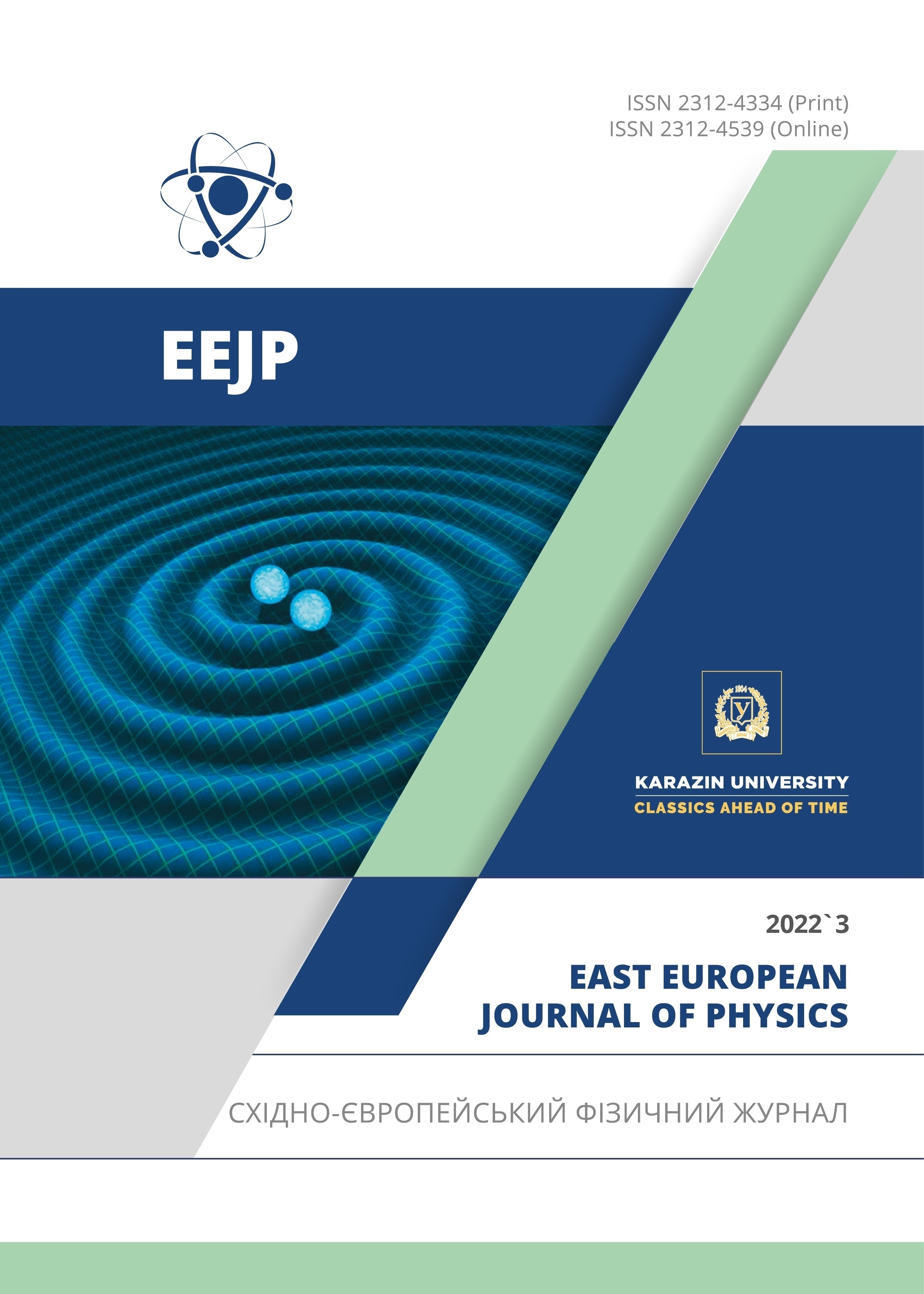Structural, Electrical and Optical Properties of Graphite Films are Drawn with Pencils of Different Hardness
Abstract
The paper presents the results of studying the structural, optical and electrical properties of thin films of graphite depending on the hardness of the rods (2H, H, HB, B and 2B) obtained by the "Pencil-on-semiconductor" method. Such studies are of great importance for the further development of highly efficient devices based on heterojunctions for electronics and optoelectronics. Typical images of the surface formed by reflected electrons (BSE) were obtained using a scanning electron microscope and shown at three magnifications (100x, 500x and 1000x). Since the cores of the studied pencils consist of mixtures of clay and graphite, a more detailed analysis of the elements that make up the cores was conducted. EDS analysis showed that the main components of the studied rods are purified graphite powder, as well as O, Al and Si, which are part of kaolin whose formula is H4Al2Si2O9, or Al2O3 • 2SiO2 • 2H2O - the main component of ordinary clay. The elemental composition of the microvolume of the studied samples was also determined. Regardless of the error that occurs when determining the composition of C and O (~ 12%), it can be argued that there is still a regularity between the graphite content and the hardness of the pencil. That is, the higher the graphite content, the softer the rod. The thickness of the graphite films was measured using the MII-4 interferometer according to the standard method. The average thickness of all investigated films was ~ 150 nm since the thickness of the films obtained by this method is mainly determined by the roughness of the surface of the salt substrate. Drawn graphite films have a higher resistivity than bulk samples (pencil rods) from which they were made. The resistance of the films increases with an increase in the hardness of pencils, due to an increase in the number of clay impurities in graphite, which is a dielectric. It was found that an increase in stick hardness leads to an increase in transmission.
Downloads
References
V.V. Brus, M.A. Gluba, X. Zhang, K. Hinrichs, J. Rappich, and N.H. Nickel, Solar energy, 107, 74 (2014), https://doi.org/10.1016/j.solener.2014.05.021
H. Parkhomenko, M. Solovan, V.V. Brus, E. Maystruk, and P.D. Maryanchuk, Optical Engineering, 57(1), 017116 (2018), https://doi.org/10.1117/1.OE.57.1.017116
K. Kostarelos, and K.S. Novoselov, Nature nanotechnology, 9(10), 744 (2014), https://doi.org/10.1038/nnano.2014.224
A.C. Neto, F. Guinea, N.M. Peres, K.S. Novoselov, and A.K. Geim, Reviews of modern physics, 81(1), 109 (2009), https://doi.org/10.1103/RevModPhys.81.109
M.D. Stoller, S. Park, Y. Zhu, J. An, and R.S, Ruoff, Nano letters, 8(10), 3498 (2008), https://doi.org/10.1021/nl802558y
M.M. Solovan, H.P. Parkhomenko, and P.D. Marianchuk, Journal of Physical Studies, 23(4), (2019), https://doi.org/10.30970/jps.23.4801
D. Neumaier, S. Pindl, and M.C. Lemme, Nature Materials, 18(6), 525 (2019), https://doi.org/10.1038/s41563-019-0359-7
M. Jung, P. Rickhaus, S. Zihlmann, A. Eichler, P. Makk, C. Schönenberger, Nanoscale, 11(10), 4355 (2019), https://doi.org/10.1039/C8NR09963D
R. You, Y.Q. Liu, Y.L. Hao, D.D. Han, Y.L. Zhang, and Z. You, Advanced Materials, 32(15), 1901981 (2020), https://doi.org/10.1002/adma.201901981
Y. Miyasaka, A. Nakamura, and J. Temmyo, Japanese Journal of Applied Physics, 50(4S), 04DH12 (2011), https://doi.org/10.1143/JJAP.50.04DH12
M. Yankowitz, Q. Ma, P. Jarillo-Herrero, and B.J. LeRoy, Nature Reviews Physics, 1(2), 112 (2019), https://doi.org/10.1038/s42254-018-0016-0
V.V. Brus, O.L. Maslyanchuk, M.M. Solovan, P.D. Maryanchuk, I. Fodchuk, V.A. Gnatyuk, and T. Aoki, Scientific reports, 9(1), 1 (2019), https://doi.org/10.1038/s41598-018-37637-w
V.V. Brus, M. Gluba, J. Rappich, F. Lang, P.D. Maryanchuk, and N.H. Nickel, ACS applied materials & interfaces, 10(5), 4737 (2018), https://doi.org/10.1021/acsami.7b17491
M.N. Solovan, G.O. Andrushchak, A.I. Mostovyi, T.T. Kovaliuk, V.V. Brus, and P.D. Maryanchuk, Semiconductors, 52(2), 236 (2018), https://doi.org/10.1134/S1063782618020185
V.V. Brus, and P.D. Maryanchuk, Carbon, 78, 613 (2014), https://doi.org/10.1016/j.carbon.2014.07.021
V.V. Brus, P.D. Maryanchuk, M.I. Ilashchuk, J. Rappich, I.S. Babichuk, and Z.D. Kovalyuk, Solar Energy, 112, 78 (2015), https://doi.org/10.1016/j.solener.2014.11.023
V.V. Brus, and P.D. Maryanchuk, Applied Physics Letters, 104(17), 173501 (2014), https://doi.org/10.1063/1.4872467
K. Chopra, and S. Das, Thin-film solar cells (Vol. 450), (Mir, Moscow, 1986).
N.F. Mott, and E.A. Davis, Electronic Processes in Non-Crystalline Materials, (Oxford University Press, Oxford, New York, 2012).
J.Y.W. Seto, Journal of Applied Physics, 46, 5247 (1975). https://doi.org/10.1063/1.321593
V.V. Brus, M.I. Ilashchuk, I.G. Orletskyi, M.M. Solovan, G.P. Parkhomenko, I.S. Babichuk, and P.D. Maryanchuk. Nanotechnology, 31(50), 505706 (2020), https://doi.org/10.1088/1361-6528/abce55
Copyright (c) 2022 Serhii I. Kuryshchuk, Taras T. Kovalyuk, Ivan P. Koziarskyi, Mykhailo M. Solovan

This work is licensed under a Creative Commons Attribution 4.0 International License.
Authors who publish with this journal agree to the following terms:
- Authors retain copyright and grant the journal right of first publication with the work simultaneously licensed under a Creative Commons Attribution License that allows others to share the work with an acknowledgment of the work's authorship and initial publication in this journal.
- Authors are able to enter into separate, additional contractual arrangements for the non-exclusive distribution of the journal's published version of the work (e.g., post it to an institutional repository or publish it in a book), with an acknowledgment of its initial publication in this journal.
- Authors are permitted and encouraged to post their work online (e.g., in institutional repositories or on their website) prior to and during the submission process, as it can lead to productive exchanges, as well as earlier and greater citation of published work (See The Effect of Open Access).








